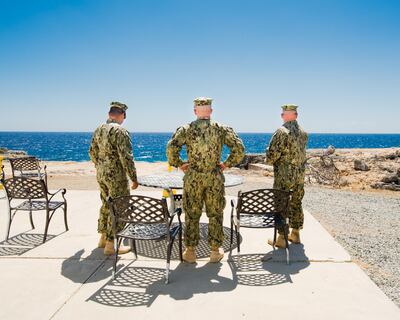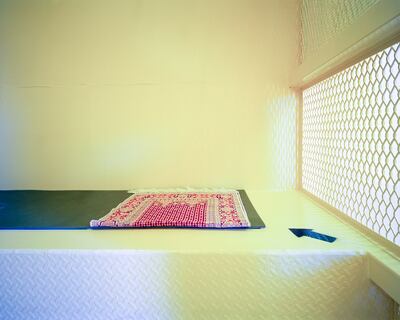Guantanamo Bay is a nowhere place. Situated on a naval base on the coast of Cuba, it is most known for its detention camp. Gitmo, as it is commonly called, is an American invention on soil that does not recognise its legality; a site with unmeasured time, where inmates are detained indefinitely and outside of clear laws; a place of unspeakable violence.
In Debi Cornwall’s images, however, Guantanamo Bay appears strangely serene and constructed, but also bright, piercing and uncanny. The photographer and filmmaker started her project on the detention camp in 2014, more than a decade after it opened and during a time when she says “people had stopped looking”.
“Most Americans had written off Guantanamo as having nothing to do with us. But Guantanamo’s prisons were established and continue to operate in the name of our safety,” she tells The National.
Her work on Guantanamo Bay comprises three series — Gitmo at Home, Gitmo at Play, which looks at residential and leisure spaces of prisoners and guards on the base; Gitmo on Sale, a visual inventory of the base’s gift-shop souvenirs; and Beyond Gitmo, environmental portraits of men released from the prison and now attempting to settle in new countries.
The photographs, compiled in her book Welcome to Camp America: Inside Guantanamo Bay, are also on view as part of the Xposure International Photography Festival in Sharjah, which runs until Tuesday.
Scroll through the gallery above for more pictures from Debi Cornwall's Guantanamo Bay series.

As part of the festival’s programme, Cornwall spoke about her project and her photography practice in general, which sorts through official narratives to find more complex and difficult truths.
A former civil rights lawyer, Cornwall worked with people who had been wrongfully convicted for 12 years. She said her law career enabled her to see systemic problems in the US criminal justice system as well as develop ways to translate legal evidence into narratives that speak to people’s situations.
In Gitmo at Home, Gitmo at Play, she attempts to break through the controlled image that the US government has tried to portray about its controversial prison camp. After spending eight months arranging the trip, Cornwall was allowed only two days on-site, where she was closely monitored and could only photograph what the guards permitted her to see.
She was also given a set of guidelines, not to show faces and to hand over her memory card so that officers could pore over the images and ensure every frame was approved.
photographer
“My challenge was to reveal the denial of personhood — and find humanity — in a place where even partial profiles of faces would be deleted by military censors. So I photographed human spaces, mostly devoid of people. In doing so, it struck me that nobody — not inmates, nor guards — chose to live in this place,” she explains.
What makes Cornwall’s images compelling is how mundane they appear at first. They don’t show chain-link fences or prison bars, but instead piles of clothing and personal items in an immaculately clean room, sunbeds looking out over deep blue waters, and in one of the more haunting images, a pair of speakers in a soundproof room (flickers of the practice of "music torture" by the US come to mind).
“Rather than duplicating the same orange jumpsuit, barbed wire and fatigues photograph we’ve seen a million times in the news, I wanted to do something different,” she says.
These crisp, saturated scenes belie the violent nature of their location. Cornwall has an eye for near-perfect symmetry, but often leaves one small detail askew to remind viewers of what we’re seeing. In one image, for example, a prayer rug is neatly folded on top of a thin mat. Light is coming in from white grate on the side, a clue that we are in fact looking at a prison cell.

Her images of Gitmo souvenirs — a Fidel Castro bobble head, fake handcuffs, a baby’s T-shirt that says “I love Guantanamo Bay” — are darkly humorous, but also demonstrate how quickly the atrocities have been painted over with American consumerism.
Though perhaps the most important part of the series are the portraits of the men who have been released from the prison. Cornwall says she was able to track them down through contacts in her former career as a lawyer. Once she met a few former prisoners, word spread among the network and she was able to meet with 14 men across nine countries. They now navigate a world post-Gitmo, in France, Egypt, Germany and Qatar, among others. Some are still stuck in legal limbo, waiting proper documentation in their new countries.
“Trauma persists long after the body is freed,” Cornwall says.
In January, Guantanamo Bay turned 20. Inside those prisons, 780 Muslim men were held without charge or trial and nine have died in custody. According to online database The Guantanamo Docket by The New York Times, 39 men remain today — 20 have been recommended for transfer to a different country, while 12 have been charged with war crimes. Seven detainees are being held indefinitely with no charges.
In this light, it is important to see Cornwall’s three series together to understand not only how the state attempts to wrangle narratives towards its own interests, but also to see the ongoing human consequences of an unjust prison complex that is still running.
Cornwall hopes that by witnessing, those who have forgotten or have chosen to forget can be once again confronted with the truth.
“We cannot un-see,” she says. “If a single photograph, or a collection of them, can create a feeling, that visceral response can be the start of a conversation. My work is designed to encourage audiences to ask hard questions.”






